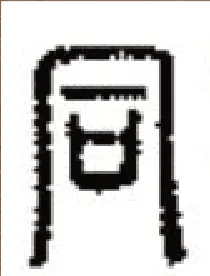tóng
By Wang Xiaoke &Zhao Shengnan
Since prehistoric times,when our ancestors hunted and collected food together,homo sapiens have been a social species.In fact,families,cities,and modern societies are all based on our tendency to live in groups and work together.Social life fulfills our needs for friends,spouses,and the indispensable approval from others.According to Jean-Paul Sartre,caring about what other people think may make your life a living hell;but to look on the bright side,you either get smothered among others or die alone,and the fear of dying alone may urge you to hate your partners less.
In China,the art of dealing with others has been repeatedly discussed for millennia.The Chinese character 同 (tóng),for example,holds many thoughts and wisdoms on the subject.
同 was first found in the oracle bone script of the Shang Dynasty (around 1600 BC–1046 BC).Its upper part is 凡 (fán,literally meaning“ordinary”),and its lower part is 口 (kǒu,literally meaning“mouth”).(See Figure 1.) Later,the upper part of the character同 gradually changed to look like a tool for carrying things,and the lower part,口,was wrapped inward (see Figure 2).In the seal script of the Qin Dynasty (221 BC-207 BC),the upper three strokes joined together to form a long curve,in which the characters 一 (yī,literally meaning “one”) and口 were written (see Figure 3).In the official script of Han Dynasty (202 BC-220 CE),this long curve was divided into two strokes to make writing easier.The character 同 in regular script (see Figure 4) was developed from this writing style and has continued to be in use ever since.
According toShuowen Jiezi,one of the earliest dictionaries,同 means “gathering and collecting.” (That was the most effective way to get food in ancient life).In China’s earliest poetry anthology,The Book of Songs,we can find the line “我稼既同 (wǒ jià jì tóng;all of my crops are collected),” and the character 同 means “collecting”here.Collecting is about sorting out things which have the same usage,so a new meaning of “the same” evolved in the character,such as in the idiom殊途同归 (shū tú tóng guī,tread different paths that lead to the same destination).Other meanings further derived from the meaning of "the same” such as “unity” and “together.” For example,in Lu You’s (1125-1210) poem line “但悲不见九州同 (dàn bēi bú jiàn jiǔzhōu tóng),“ he lamented how sad he was that he could not see “九州同 (jiǔzhōu tóng;the unity of the country)” before the end of his life,while in the commonly used idiom 同舟共济 (tóng zhōu gòng jì,those in the same boat should row together),同means “together.”
From the perspective of grammatical function in modern Mandarin,同 is often used as a preposition,conjunction,or an adverb.For example,in the sentence “我同她是好朋友 (Wǒ tóng tā shì hǎo péngyǒu;She and I are good friends),” 同 is used as a conjunction to mean “and”;in “这里的气候同那里一样 (Zhèlǐ de qìhòu tóng nàlǐ yīyàng;The climate here is the same as there),” 同 is used as a preposition to mean “being the same”;in the word 同学(tóngxué;literally meaning schoolmate,“those who learn together”),同 is used as an adverb to modify 学 (xué,learning).
The ancient Confucian and Taoist philosophers used the character 同 to establish their conception of an ideal society,大同社会 (dàtóng shèhuì),in which 大同 (dàtóng) can be understood as “all-harmony”or “utmost stability.” But because of the rich meanings of character 同,大同 can easily be understood by common people as “all being the same.”As you can imagine,this misunderstanding could lead to the stifling of personality and creativity.
Fortunately,someone noticed this and tried to clarify.One of the greatest thinkers in human history,Confucius,used 同 (sameness)as a negative concept in his famous remarks “君子和而不同,小人同而不和 (Jūnzǐ hé ér bù tóng,xiǎorén tóng ér bù hé;The true gentleman values harmony in diversity;the hypocrite values sameness but not harmony).” Here Confucius put 同 (sameness) at the opposite end of 和 (harmony)and “diversity,” which are a treasure of a “true gentleman.”By his effort,和而不同 (hé ér bù tóng) has become a very famous thought as well as the ethical,political,and social principle of Confucianism.Men of virtue should avoid the trap of 同 (sameness) and be guided by the principle of 和(hé;harmony).They should be broad-minded,tolerant,good at listening to different opinions,but never blindly agree with others.
Nowadays,maintaining differences and individuality in harmony is still the philosophy of many Chinese people.Minority groups are generally accepted and respected in our society.As a nation,China’s diplomacy also sticks to this ancient wisdom.The postcolonial logic of monotheist superpowers is “do as I want,or you will perish.” While China says “Be yourself,we can still get along.” If people of the world could understand both the positive and negative meanings of 同,we could perhaps learn how to listen to more voices than the prejudiced mass media,make friends while keeping our individuality,and together make our planet a place of“harmony in diversity.”

Figure 1

Figure 2

Figure 3

Figure 4

